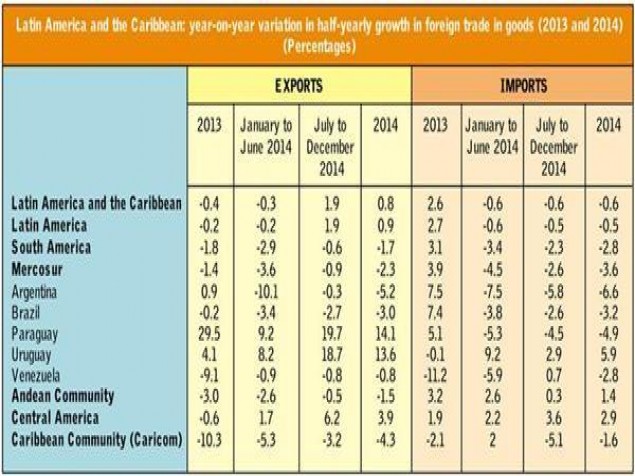10/10/2014 |
Mercosur is worst performer in LatAm as exports are set to plunge 2.3%
Argentina’s exports and imports will drop the most out of all of the countries in the Mercosur trade bloc this year, plunging 5.2 and 6.6 percent, respectively, according to estimates by the UN’s Economic Commission for Latin America and the Caribbean (ECLAC).
It will be a negative year for the Mercosur as a whole, which will see exports plunge 2.3 percent and a 3.6 percent decrease in imports.
The region is the one that fares the worst for all of Latin America, which will at least see positive growth, even if small. Latin America and the Caribbean will see exports rise 0.8 percent on average this year. Imports though will fall 0.6 percent in 2014, after rising 21.7 percent in 2011, and three percent in 2012 and 2013.
The weak performance of the region’s foreign trade is primarily due to weak demand from some of its main markets, particularly the European Union, as well as an important decline in trade within Latin American countries.
A lower price for commodities — a top export for the region — also played a significant role in this decline.
Argentina in particular saw negative numbers with exports dropping 10.1 in the first semester of the year — the second highest in the region after Peru — and imports plunging 7.5 percent, the highest of the region.
Despite these concerning foreign-trade figures, the country’s trade balance continues to be in positive territory for the year, accumulating a US$4.487 billion surplus — but that is 19 percent lower than the same period last year.
“Argentina doesn’t have the same characteristics as the other countries of the region, where there’s an important output and dividend remittances. Argentina has restricted that in order to use those profits for new investments for the country and with the objective of improving the exports platform in the medium term,” ECLAC Executive Secretary Alicia Bárcena said yesterday.
“Restricting the repatriation of profits isn’t something that is negative or positive. On the contrary, countries should encourage funds to remain in their territory,” Bárcena said, when asked about Argentina. “It would be ideal for all companies to reinvest their dividends in the region.”
Argentina is not the only Mercosur member that will see foreign trade plunge this year.
Brazil, for example, will see its sales abroad plunge three percent this year and its imports 3.2 percent.
The smaller Mercosur members though will have a very positive year. Paraguay, for example, is expected to see exports soar 14.1 percent and imports drop 4.9 percent, while Uruguay will see exports rise 13.6 percent and imports increase 5.9 percent.
The more northern countries — including Mexico and Central America — will see increases in large part due to improved economic conditions in the United States.
Small participation
In the report, ECLAC underscores that Latin American and Caribbean countries have a minimal participation in the world’s three main global value chains (North America, Europe and Asia). With the exception of Mexico, the region is not an important provider of non-commodities intermediate goods to the world, nor does it carry much weight as an importer.
Becoming a more important player in global trade could help the region develp a type of commerce that not only favors growth and productivity, but also leads to a decrease in inequality.
Ultimately, the region needs to worry about stopping its reliance on commodities in order to increase trade in value-added goods.
In the document, ECLAC also calls on the region’s countries to particularly strengthen regional integration and cooperation, since they represent an essential path for diversifying the region’s production and trade structure.
“The regional market is key to developing value chains in Latin America and the Caribbean. Deepening this market is an indispensable strategy for advancing toward a global insertion that is more conducive to structural change,” Bárcena said.
Source:
Buenos Aires Herald
